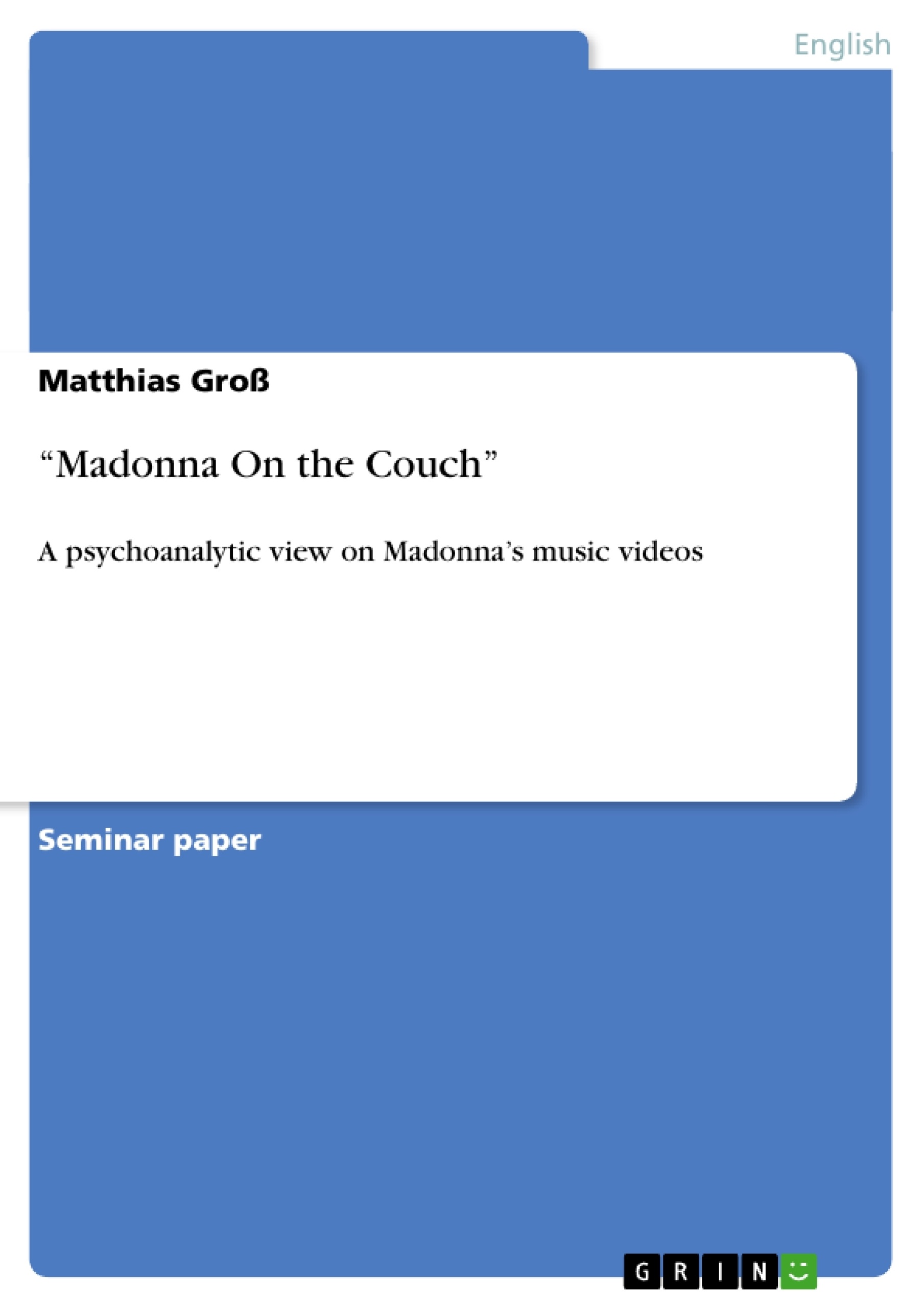This paper is taking interest in Madonna and psychoanalysis, yet it is not supposed to conclude as an analysis of Madonna and her psychic condition as a patient. However, what I am trying to do on the following pages is to detect and employ various concepts of Freud’s revolutionary theory (or rather theories) in the context of pop star Madonna and her music videos in particular. Initiated by a seminar on psychoanalysis and literature, this paper tries to portray how influential Freud’s findings were and to this day still are, but probably also that the post-Freudian society at times seems to escape into thoroughly explaining matters with the help of their layman understandings and ideas of psychoanalysis. What I am trying to say is that one is tempted to overdo interpretations with the help of psychoanalysis, ignoring the fact that it has limitations as well. I noticed myself, especially, becoming oblivious to that fact when analyzing Madonna. That occurrence, however, exemplifies how prone we are, as post-Freudians, to employ this theory in our thinking, understanding, and interpretation of ideas and concepts; not only in academic spheres, but also in everyday life.
I have tried to structure this paper in accordance of the various psychoanalytic concepts that I chose to discuss in regard to Madonna’s music videos. However, my intended agenda for this essay proved somewhat incompatible with my findings, which means that quite frequently there was no clear-cut distinction to make between, for instance, the universal prominence of sexuality and the dream and their overall importance in applying psychoanalytic theory on literary texts (in this case on music videos and sequences). Owing to better readability and coherence, however, I still arranged this paper in chapters, pointing out once more that cross-references and repetitions to some extent are indispensable.
Since the focus of this paper is on Madonna’s music videos, visual representations so to speak, I start out discussing the importance of psychoanalysis and its ramifications for film theory. I have struggled with the equalization of entire films, in which film theory is based, and music videos; yet I have found that these sequences, in a way, tell entire stories as well, and, owing to their limitations in regard to the time frame, are condensed to a much larger extent than are ordinary films, which is reflected in the frequent employment of symbolism and ciphers in music-video composition (This condensation itself implies a close similarity to Freud’s comments about the dream-work.) Beginning with general theoretical observations on film theory and psychoanalysis in terms of modes and conventions of perception I will lead to the discussion of the actual contents of Madonna’s music videos in regard to at least some of Freud’s ideas.
Inhaltsverzeichnis (Table of Contents)
- Introductory Remarks
- Part I – Preliminary Theory
- Psychoanalysis And Film: A Theoretical Cross-Over
- The Dream Screen: Dream Work And Cinema
- Part II Madonna Meets Freud
- Die Another Day or: “The Dissection of the Psychical Personality”
- Human Nature or: “Beyond the Pleasure Principle”
- Frozen or: “The Uncanny”
- Conclusion or: \"Psychopathic People On the Stage\"
- Bibliography
Zielsetzung und Themenschwerpunkte (Objectives and Key Themes)
This paper analyzes Madonna's music videos through the lens of Freudian psychoanalysis, aiming to explore the relevance and application of Freud's theories in the context of popular culture. The paper investigates the influence of Freud's ideas on contemporary society and how psychoanalysis is employed in interpreting cultural phenomena, particularly in popular music.
- The interplay between psychoanalysis and film theory
- The role of the unconscious in shaping individual and cultural perceptions
- The significance of dreams and dream work in understanding the human psyche
- The application of psychoanalytic concepts to interpret Madonna's music videos
- The influence of Freud's theories on contemporary society and cultural practices
Zusammenfassung der Kapitel (Chapter Summaries)
The paper begins with a discussion on the relationship between psychoanalysis and film theory, exploring how Freudian concepts can be applied to cinematic analyses. The chapter highlights the importance of the unconscious in understanding cultural practices and the symbolic language employed in film. The second chapter explores the concept of the dream screen and how it relates to the cinematic experience. It examines the dream work and its connection to the construction of meaning in music videos. The paper then moves on to discuss the application of psychoanalytic concepts to Madonna's music videos. The analysis focuses on the themes of sexuality, the unconscious, and the interplay of these elements in shaping the visual narrative of her music videos.
Schlüsselwörter (Keywords)
The primary keywords and focus topics include psychoanalysis, film theory, Madonna, music video, dream work, unconscious, sexuality, cultural practices, and the influence of Freudian theory on contemporary society.
- Quote paper
- Matthias Groß (Author), 2007, “Madonna On the Couch” , Munich, GRIN Verlag, https://www.grin.com/document/94156



